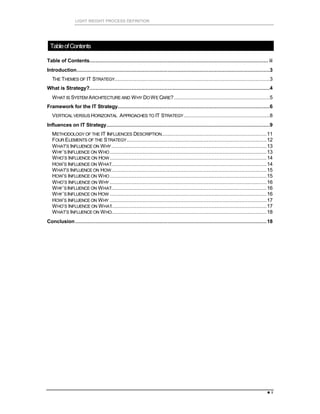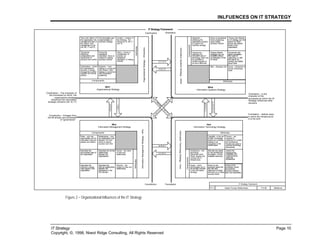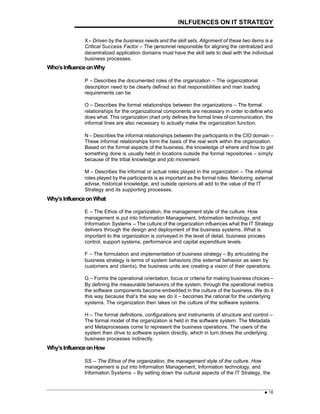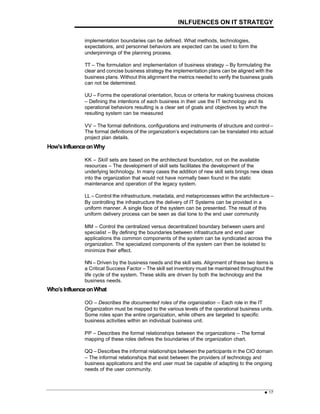This document discusses the influences on information technology (IT) strategy and its impact on system architecture, emphasizing the need for alignment with business activities to achieve strategic fit. It outlines the framework for developing an effective IT strategy, highlighting the importance of integration, adaptability, and the distinction between operational effectiveness and strategy. The paper also explores various components and approaches to IT architecture, advocating for a focus on higher-level views for successful business deployment.


![INFLUENCES ON IT STRATEGY
IT Strategy Page 3
Copyright, ©, 1998, Niwot Ridge Consulting All Rights Reserved
Introduction
This White Paper presents a look at the influences on the outcome of an Information Technology
Strategy. This IT Strategy can be applied to enterprise–wide system development or deployment
activities as well as more focused efforts of a single project.
This IT Strategy provides a guide to the to the strategic activities to be taken during the course of an
Information Technology project.
An IT Strategy must address the following activities:
n Aligning the IT Strategy with Business Plans.
n Defining the target business units that make use of the various system components.
n Defining the applications suites that can be deployed against these target business units.
n Defining the architectural alternatives for the system environment.
n Defining the processes used to map the business requirements against the system architecture.
n Defining the detailed strategies for managing the data.
n Defining the strategies for procuring Commercial Off The Shelf software systems.
n Defining the technical infrastructure needed to deploy the system.
n Defining the organizational changes needed to support the system.
This White Paper describes a framework for discovering the influences on IT Strategy and the impact
of these influences on the resulting system architecture.
TheThemesofITStrategy
The IT Strategy contains three (3) major themes. These themes form the foundation of the IT Strategy
as well as the tactical processes that will be deployed in support of these strategies.
[1]
These themes are:
n Business improvements are enabled by Information Technology that is integrated not
disintegrated. This integration must be horizontal versus vertical. Horizontal systems remove
islands of information and build bridges between the business units. In this integrated system,
multiple data sources are made transparent to the end users as well as the applications that utilize
them.
n Information Technology requirements are always growing, changing, and being extended. The
Information Technology is no longer static, but dynamic adapting to the changing business
requirements.
n Information Technology is about abstractions. If only hardware, software and data were the only
foundations of a system, then Information Technology would not be able to keep pace with the
business requirements. Instead, business processes, objects and services are the foundation of
the system, which then drive the business processes in their adaptation of the changing market
forces.
1
“Integrating IS and the Organization,” Michael Earl, CRIM WP95/4, Centre for Research in InformationManagement,London
Business School.](https://image.slidesharecdn.com/influencesonitstrategy-190317185435/85/Influences-on-IT-strategy-3-320.jpg)
![INFLUENCES ON IT STRATEGY
IT Strategy Page 4
Copyright, ©, 1998, Niwot Ridge Consulting All Rights Reserved
What is Strategy?
Strategy is creating fit among a company’s activities. The success of a strategy depends on doing
many things well – not just a few. The things that are done well must operate within a close nit system.
If there is no fit among the activities, there is no distinctive strategy and little to sustain the strategic
deployment process. Management then reverts to the simpler task of overseeing independent
functions. When this occurs operational effectiveness determines the relative performance of the
organization.
[2]
Improving operational effectiveness is a necessary part of management, but it is not strategy. In
confusing the two, managers will be unintentionally backed into a way of thinking about competition
that drives the business support processes (IT) away from the strategic support and toward the tactical
improvement of operational effectiveness.
Managers must be able to clearly distinguish operational effectiveness from strategy. Both are
essential, but the two agendas are different. The operational effectiveness agenda involves continual
improvement business processes that have no trade–offs associated with them. The operational
effectiveness agenda is the proper place for constant change, flexibility, and relentless efforts to
achieve best practices. In contrast, the strategic agenda is the place for making clear tradeoffs and
tightening the fit between the participating business components. Strategy involves the continual
search for ways to reinforce and extend the company’s position in the market place.
The concept of fit among functional units is one of the oldest ideas in strategy. Gradually however, it
has been supplanted with new concepts of core competencies, critical resources and key success
factors. In fact fit is far more critical to the success of the IT systems than is realized.
[2]
Strategic fit
among the various systems components and the business processes they support is fundamentalnot
only to competitive advantage but also to the sustainability of that advantage.
Fit among a company’s activities creates pressures and incentives to improve operational
effectiveness. Fit means that poor performance in one activity will degrade the performance in others,
so that weaknesses are exposed drawing management’s attention. Conversely, with increasing fit,
improvements of one activity will pay dividends in other areas.
The challenge now is to create fit among the IT components and their matching business
components.
2
“What is Strategy,” M. E. Porter, Harvard Business Review, Volume 74, Number 6, pp. 61–78.
Jack Welch Speaks: Wisdom from the World’s Greatest Business Leader,J.WelchandJ.C.Lowe,JohnWiley&Sons,
1998.
Control Your Destiny or Someone Else Will: Lessons in Mastering Change–From the Principles Jack Welch Used to
Revolutionize GE, N. M. Tichy and S. Sherman, Harpers Business, 1994.](https://image.slidesharecdn.com/influencesonitstrategy-190317185435/85/Influences-on-IT-strategy-4-320.jpg)
![INFLUENCES ON IT STRATEGY
IT Strategy Page 5
Copyright, ©, 1998, Niwot Ridge Consulting All Rights Reserved
WhatisSystemArchitectureandWhyDoWeCare?
If we were setting out to build a home, we would first lay out the floor plans, grouping each room by
function and placing structural items within each room according to their best utility. This is not an
arbitrary process – it is architecture. Moving from home design to IT system design does not change
the process. Grouping data and processes into information systems creates the rooms of the system
architecture. Arranging the data and processes for the best utility is the result of deploying an
architecture. Many of the attributes of building architecture are applicable to system architecture.
Form, function, best use of resources and materials, human interaction, reuse of design, longevity of
the design decisions, robustness of the resulting entities are all attributes of well designed buildings
and well designed computer systems.
[3]
In general, an architecture is a set of rules that defines a unified and coherent structure consisting of
constituent parts and connections that establish how those parts fit and work together. An architecture
may be conceptualized from a specific perspective focusing on an aspect or view of its subject. These
architectural perspectives themselves can become components in a higher–level architecture serving
to integrate and unify them into a higher level structure.
The architecture must define the rules, guidelines, or constraints for creating conformant
implementations of the system. While this architecture does not specify the details on any
implementation, it does establish guidelines that must be observed in making implementation choices.
These conditions are particularly important for component architectures that embody extensibility
features to allow additional capabilities to be added to previously specified parts.
[4]
This is the case
where Data Management is the initial deployment activity followed by more complex system
components.
By adopting a system architecture motivation as the basis for the IT Strategy, several benefits result:
n Business processes are streamlined – a fundamental benefit to building enterprise information
architecture is the discovery and elimination of redundancy in the business processes
themselves. In effect, it can drive the reengineering the business processes it is designed to
support. This occurs during the construction of the information architecture. By revealing the
different organizational views of the same processes and data, any redundancies can be
documented and dealt with. The fundamental approach to building the information architecture is
to focus on data, process and their interaction.
n Systems information complexity is reduced – the architectural framework reduces information
system complexity by identifying and eliminating redundancy in data and software. The resulting
enterprise information architecture will have significantly fewer applications and databases as well
as a resulting reduction in intersystem links. This simplification also leads to significantly reduced
costs. Some of those recovered costs can and should be reinvested into further information
system improvements. This reinvestment activity becomes the raison d’état for the enterprise–
wide system deployment.
n Enterprise–wide integration is enabled through data sharing and consolidation – the information
architecture identifies the points to deploy standards for shared data. For example, most Kimball
business units hold a wealth of data about products, customers, and manufacturing processes.
However, this information is locked within the confines of the business unit specific applications.
The information architecture forces compatibility for shared enterprise data. This compatible
information can be stripped out of operational systems, merged to provide an enterprise view, and
stored in data repositories. In addition, data standards streamline the operational architecture by
eliminating the need to translate or move data between systems. A well–designed architecture not
only streamlines the internal information value chain, but it can provide the infrastructure
3
A Timeless way of Building, C. Alexander, Oxford University Press, 1979.
4
“How Architecture Wins Technology Wars,” C. Morris and C. Ferguson, Harvard Business Review,March–April1993,pp.
86–96.](https://image.slidesharecdn.com/influencesonitstrategy-190317185435/85/Influences-on-IT-strategy-5-320.jpg)
![INFLUENCES ON IT STRATEGY
IT Strategy Page 6
Copyright, ©, 1998, Niwot Ridge Consulting All Rights Reserved
necessary to link information value chains between business units or allow effortless substitution
of information value chains.
n Rapid evolution to new technologies is enabled – client / server and object–oriented technology
revolves around the understanding of data and the processes that create and access this data.
Since the enterprise information architecture is structured around data and process and not
redundant organizational views of the same thing, the application of client / server and object–
oriented technologies is much cleaner. Attempting to move to these new technologies without an
enterprise information architecture will result in the eventual rework of the newly deployed system.
Framework for the IT Strategy
Before proceeding with an IT Strategy, a framework is needed to represent the various views of the IT
System. In this paper the Framework can be based on the seminal work of John A. Zackman.
[5]
Using
the architectural paradigm, the Framework provides answers to:
n What – is the system made of? What components are assembled to make the system what it is?
How are these components connected? What are the mechanisms used to connect the
components?
n How – does the system work? What are the details of the system integration? What tools have
been used to integrate the components? Are these tools appropriate for the task at hand?
n Where – are the components of the system located relative to one another? What is the topology
for the data and processes? How is this topology managed?
n Who – does what relative to these system components? How do the users interact with the
system? How is access controlled to the system resources?
n When – do things happen in the system? What is the sequence of events within the system? How
is work routed through the system? How are the users notified that work is ready, complete,
suspended, canceled?
n Why – are various system choices being made? What is the underlying architecture of the
system? How did the system components come to be connected? How will these components be
migrated to the next generation?
The Framework provided through this approach is:
n Simple – since it is easy to understand. In its most elemental form, it provides three perspectives:
The Owner, the Designer, the Builder and three abstractions: Material, Function, and Geometry.
n Comprehensive – is addresses the Enterprise in it entirety. Any issues can be mapped against the
Framework to understand where they fit within the context of the Enterprise as a whole.
n Language – it helps develop a set of thought processes for addressing complex concepts and
communicates them precisely with few, non–technical words.
n Planning Tools – it helps the participants make better choices since these choice are no longer
made without a context.
n Problem Solving Tool – is enables the participants to work with abstractions, to simplify, to isolate
simple variables without losing sense of the complexity of the Enterprise as a whole.
n Neutral – is it defined totally independently of tools or methodologies and therefore any tool or any
methodology can be mapped against it to understand their implicit tradeoffs.
The Framework for Enterprise Architecture is not the answer. It is a tool for thinking about the
answers.](https://image.slidesharecdn.com/influencesonitstrategy-190317185435/85/Influences-on-IT-strategy-6-320.jpg)
![INFLUENCES ON ITSTRATEGY
IT Strategy Page 7
Copyright, ©, 1998, Niwot Ridge Consulting All Rights Reserved
[5]
Data Function Network People Time Motivation
Scope
What is the span of
interest for the system
and its users?
List of things important
to the business units
and the data that
represents them.
List of processes the
business units perform
and the operations to
be incorporated into
the system.
List of locations in
which the business
operates
List of organizations
important to the
business and their
interactions with the
system.
List of events
significant to the
business units
List of business goals
and strategies to be
addressed by the
system.
Enterprise Model
How are the process
and data elements
arranged w ithin the
enterprise?
Semantic models
describing the
meaning and use of
the data elements.
Business process
models describing
how the data is used
within each business
process.
Logistics models
describing the logical
connectivity between
the various system
components.
Work flow models
describing the steps
taken for each work
process.
Master schedules
describing the
temporal sequencing
of the business
processes.
Business plan
describing the cost
and benefits of
automating each
business process.
System Model
How are the process
and data elements
arranged within the
logical system?
Logical data model for
each process in the
system.
Application
architecture describing
the connections
between the various
applications.
Distributed system
architecture describing
network arrangement
of each processing
element.
Human interface
architecture describing
the various user
interface components.
Processing structure
describing the
processing sequences
of each application
step.
Business rule model
describing the
business rule for each
process and data
element.
Technology Model
What are the
technological
elements of the
system?
Physical data model
each process in the
system.
System design of the
application and data
elements
System architecture
describing the
arrangement of the
technological
elements of the
system.
Presentation
architecture describing
the mechanisms of
presenting information
to the users
Control structure
describing the
interconnections
between the
processing steps in
terms of sequence
and effectiveness.
Rule design
describing the detailed
business rules for
each processing step
and the associated
data.
Detailed
Representation
How are these
elements represented
in practice?
Data definition for
each element in the
data models
Programs used to
implement the system.
Network architecture
for the actual
hardware and
software components.
Security architecture
for each application
and user community.
Timing definitions for
each application and
associated data.
Rule specification for
each data and
process access
sequence.
Figure 1 – Zackman Enterprise Architecture Framework
5
This table is taken from John Zachman’s original works, “A Framework for Information Systems Architecture,” J. A. Zachman, IBMSystemsJournal,Volume26,Number3,
1987. “Extending and Formalizing the Framework for Information Systems Architecture,” J. F. Sowa and J. A. Zachman, IBMSystemsJournal,Volume31,Number3,1992.](https://image.slidesharecdn.com/influencesonitstrategy-190317185435/85/Influences-on-IT-strategy-7-320.jpg)
![INFLUENCES ON IT STRATEGY
IT Strategy
Copyright, ©, 1998, Niwot Ridge Consulting All Rights Reserved
VerticalversusHorizontal ApproachestoITStrategy
The IT Framework in Zachman’s works describes five (5) increasingly detailed levels or views: scope,
enterprise model, system model, technology mode, and detailed representation of three (3)
architectural components: data, process and technology (see Figure 1):
The majority of strategic business and technology breakthroughs using this approach are found within
the top rows of Figure 1. The first two rows are business management views of the architecture that
have nothing to do with the underlying technology. The lower levels of the architecture have to do with
building actual applications and databases. The focus of the IT Strategy will be on the top levels of
Figure 1 for the following reasons:
n Having a plan is necessary to ensure success, but it not sufficient. Most architectural efforts skim
through the higher–level views and spend months or even years becoming mired in the technical
details of the system. The high–level view defines the boundaries of what should be automated in
any one information system. This approach focuses the effort on successful business
deployment, not just the technical details of the products and services.
n The higher–level views of the system are the foundation and must stand the test of time. The
lower levels of the architecture are actually unstable due to the rapidly changing technology
environment.
n In order to gain control over the technology assets, the business units need to understand that
architecture provides the structure that guides, scopes, and controls the implementation process.
Many significant breakthroughs occur during the development of the business views of the
enterprise information architecture.
Within the IT Framework, there are two (2) primary approaches to IT System Architecture:
n Vertical – which creates disconnections between the various architectural components. This
organization comes about by developing systems to meet the needs of individual use groups,
rather than the needs of the business enterprise.
The information technology psyche begins at the department level or lower, rather than at the
business or enterprise level. As a result, the system’s design becomes very department–
dependent, often to the point at which expenditures and activities were optimized to the benefit of
the department and the detriment of the enterprise.
[6]
Placing the emphasis on end–user satisfaction continues to encourage this departmental myopia,
creating vertical systems with their own proprietary data, software, and technology components.
Each system is optimized for productivity within the department, not the enterprise.
n Horizontal – using the architectural concept of planned deployment, the enterprise information
systems architecture framework described in Figure 1 provides an alternative approach to the
departmental isolation of the vertical system architecture. This architecture allows integration and
coordination across the enterprise. This integration and coordination always requires a shift away
from the vertical or proprietary approach to a horizontal approach that cuts across the
organizational lines of data and process ownership.
The Value of Architecture
Software architecture design is intimately related to life cycle cost. A well–designed software architecture represents a
valuable investment that yields adaptability to new requirements and technologies over the system’s life cycle.
6
L. Runge, Computerworld, October 24, 1994, pp. 113.](https://image.slidesharecdn.com/influencesonitstrategy-190317185435/85/Influences-on-IT-strategy-8-320.jpg)
![INFLUENCES ON IT STRATEGY
IT Strategy
Copyright, ©, 1998, Niwot Ridge Consulting All Rights Reserved
InfluencesInfluences on IT Strategy
The IT Strategy components described above are based on the physical and logical technologies of
the IT Infrastructure. These describe how, what, when, and where to technology of the IT Strategy is
to be deployed. The effects of this technological deployment are another element of the IT Strategy. In
the Zachman approach to IT Strategy is supply side focused and the domain of IT professionals.
[7]
In
order to complete the IT Strategy the influences of these technologies on the organizational aspects of
the business must be understood. The questions to be answered include:
n What IT applications should be deployed to yield competitive advantage?
n What technological opportunities should be considered?
n What IT platforms should be deployed and what IT policies are needed to manage these
platforms?
n Which IT capabilities should be nurtured and which should be acquired from outside sources?
n How should IT activities be organized and what is the role of the IT function?
n What is management’s role in the IT domain and what IT capabilities are required for today’s
managers?
The answers to these questions involve determining how the components of the IT Strategy Fit
together and how they are Interrelated. The influences approach to IT Strategy is based in a simple
and effective view of how business executives are able to conceptualize strategic decision-making
processes in the domains of:
n Organizational Strategy
n Information Systems Strategy
n Information Technology Strategy
n Information Management Strategy
It is the discovery and description of the interdependence between these four (4) strategies to forms
the basis of this approach.
7
Integrating IS and the Organization: A Framework of Organizational Fit,MichaelJ.Earl,LondonBusinessSchool,Centrefor
Research in Information Management Working Paper, CRIM WP95/4.
“Information Technology Planning in he 1990’s: Directives for PlanningandResearch,”A.C.Boynton,MISQuarterly,March
1987.
Information Management: The Organizational Dimension, M. J. Earl, Oxford University Press, 1996.
The Chief Information Officer: A Study of Survival, M. J. Earl, Centre for Research in Information ManagementWorking
Paper WP93/3, reprinted as WP95/1, London Business School.
“Experiences in Strategic Information Systems Planning,” M. J. Earl, MIS Quarterly, Volume 17, Number 1, March, pp. 1-24,
1993.
Information Management: The Strategic Dimension, M. J. Earl, Oxford University Press, 1988.
“Information Systems Strategy Formulation,” in Critical Issues in Information Systems Research, edited by R. J. Boland and
R. A. Hirscheim, John Wiley and Sons](https://image.slidesharecdn.com/influencesonitstrategy-190317185435/85/Influences-on-IT-strategy-9-320.jpg)








